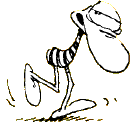 Caloi
Caloi
Clemente is a striped bird-thing, who has apparently stood around for twenty years and made snide comments on the state of Argentina. It's mostly for insiders, I think... e.g., 42 strips in a row decrying foreign words in Spanish gets to be a bit much.
One amusing bit: Clemente's grandfather, who speaks mostly in Italian-- a comment on the ethnic makeup of many a porteño.
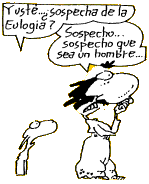 One of the funniest and most popular of Argenine strips; only Mafalda is more
ubiquitous. Pereyra is a gaucho, the Argentine equivalent of a cowboy--
although he's hardly glamorized: he's unkempt, barefoot, and rancorous.
He doesn't get along so well with his consort, Eulogia (they haven't married because he views "till death do we part" as an invitation to
homicide) or the local Indians; his one confidant is his dog Mendieta.
One of the funniest and most popular of Argenine strips; only Mafalda is more
ubiquitous. Pereyra is a gaucho, the Argentine equivalent of a cowboy--
although he's hardly glamorized: he's unkempt, barefoot, and rancorous.
He doesn't get along so well with his consort, Eulogia (they haven't married because he views "till death do we part" as an invitation to
homicide) or the local Indians; his one confidant is his dog Mendieta.
I read book #22, but the strip is still fresh and laugh-out-loud funny. Though Fontanarrosa feels free to comment on anything from Martín Fierro to Argentine politics to Michael Jackson, the staples of his humor are puns and the garden path joke:
Inodoro: It isn't cheap to have a ranch! Tin, for example, is sky-high...
Mendieta: Expensive?
Inodoro: No. It was blown away in the last windstorm.Inodoro: There's also healing mud. An uncle of mine got cured that way... he was suffering because of the bones.
Eulogia: He had rheumatism?
Inodoro: No, he was a gambler. He had terrible luck with the dice.Rosita: There's a girl in the town going around saying that you're the father of her twins.
Inodoro: That's an exaggeration, Rosita... one of them, maybe, but not both.
Maitena is an Argentine cartoonist, whose major subject is the everyday trials of being a woman in the modern middle class; generally it will provoke bemused nods of recognition rather than howls of laughter. Los Estados Unidos make an appearance, as a place dangerous to take kids 5 to 10 to (they want to buy everything).
A thoroughly weird book, centered on an irascible, hubristic magician and his encounters with cow-women, genies, talking toads, God, orphans, and his mother. Nine can draw, in a caricatured way, and he has a gift for Krazy Kat-like landscapes, but the surrealism kind of gets in the way of anything else. There's a lot about the tango in there, so it may help to be porteño.
Ezra Winston is an antique dealer in London, who follows a series of omens to meet Mort Cinder-- recently hanged as a criminal; but Mort has a penchant for returning from the dead. He ends up working for Ezra and telling him stories of his past lives (or sometimes dragging him back in time). It touches on horror, science fiction, and mystery, and it's drawn in an impressive impressionistic way, though the pacing is occasionally too languid. I have to say, Breccia is unmatched in drawing profoundly ugly men.
The idea is simple: Oski has taken actual extracts from early cronistas-- contemporary historians and diarists-- and added full-page illustrations, to form a satirical history of Argentina from the time of the Indians onward.
Another of his classic works illustrates medieval and Renaissance medical techniques, again using extracts from contemporary sources.
 Lino Palacio
Lino Palacio
One of the classic Argentine comic artists, with an elegant caricatury style-- something that would've fit in The New Yorker. He did illustrations, political cartoons, one-off strips, and a few series. Ramona is a hot-tempered, rather dim maid; Don Fulgencio is "the man who had no childhood" and seems to be making up for it; there's an amusing series about a man whose shadow has a life of its own.
My wife says that Condorito used to be pretty funny; Condorito is a condor, naturally enough, and a complete sin vergüenza (shameless con). He has a sexy girlfriend, Yayita, and an array of stereotypical foils. I like the names of Yayita's parents: Don Cuasimodo and Doña Tremebunda.
Nowadays, it's pretty much like the gag comics I read as a kid, down to every one-page 'story' needing its own title. People even fall down with a loud PLOP when they hear the punchline. On the plus side, it's one of the few Spanish comics you can find here-- look in any Mexican grocery store.
 Mafalda
1964
Mafalda
1964
Most of the world knows this classic comic strip, but not Americans. A kid strip, similar to Peanuts in tone, but with an indignation about injustice that expresses its Latin American roots. Manolito, Susanita, Mafalda herself, are as distinctive and archetypal as Linus or Lucy or Charlie Brown.
Mundo Quino [Quino's world] 1963
Déjenme inventar [Let me create] 1983
Quinoterapia [Quinotherapy] 1985
¿Como van los negocios? [Hows business?] 1987
Sí... cariño [Yes, dear] 1987
¿Quien es el jefe? [Who's the boss?] 1990
¡A mí no me grite! [No one yells at me!] 1999
For years-- since before Mafalda, in fact-- Quino has had a page in an Argentine magazine to do with what he wills. He's filled it with simple, often wordless cartoons that form a sort of ironic running commentary on modern civilization. Some offer wry recognition, some outrage; all are inventive and playful. As Charles Schulz says about them:
"The kind of ideas that he works with are one of the most difficult, and I am amazed at their variety and depth. Also, he know how to draw, and to draw in a funny way. I think that he is a giant."
Patoruzú is an Argentine Indian of superhero strength and noble character; his foils are his pear-shaped, dim brother Upa and a greedly and cowardly friend, Isidoro. I'm told that in the old days much of the humor came from the clash of cultures-- Indian cacique amok in Buenos Aires. (This is as much or more of a clash as a Mohican in New York; Argentina's Indian policy was about as nasty as ours.) I've only seen a tiny bit of Quinterno's original, however.
The present-day remnant is a moderately amusing kids' strip. In tone, style, and plot, it's like nothing so much as the Scrooge McDuck stories. There's the same mild slapstick, the same villains, the same impossibility of detecting what decade we are in (but no such confusion as to place; Patoruzú and friends are definitely, defiantly Argentine).
There's also Patoruzito, the child version of Patoruzú, who hangs with Isidorito (who, even as a child, has Isidoro's receding hairline).
Underachievement Argentine style: Gaspar is a former campus radical who's now a functionary for the telephone company, in analysis, with three children. He attempts without much success to retain his left-wing cred, while his teenage daughter Auxilio discovers boys and rock, and the baby twins learn how to crawl and wonder, while nursing, why there's a suffering man hung round Mama's neck.
Cute kid strips are the same the world over-- although Rep's editors allow him some risqué content he wouldn't have in the States-- and Rep can't really draw, but it's fairly amusing. Some high points: the duel of '60s and '90s rock; the Phantom of Underemployment; Gaspar's Mr. Hyde moment.
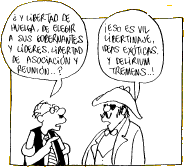 Los Supermachos 1965
Los Supermachos 1965
Real live Mexican funnies; interesting to compare to Gilberto Hernandez's Palomar, which turns out to be highly idealized. Rius's San Garabato de las Tunas, though its machos are no smarter than Palomar's, is no happy matriarchy; the reigns of power are tightly held by the local landowner and other whites, and they do as they please with the Indians (who nonetheless win a moral victory or two). The main character is a sardonic Indian named Calzónzin, whose poncho is an electric blanket.
This is only one of Rius's works, which are up to 75 or more. There's several volumes of another comic series, Los Agachados, as well as such volumes as Como Suicidarse Sin Maestro ('How to commit suicide without a teacher') and La guia incompleta del jazz ('The incomplete guide to jazz').
Cuba para Principantes [Cuba for Beginners] 1960s
Also Marx, Lenin, Domino, Philosophy; as well as Hitler for Masochists
Rius started the "---- For Beginners" series which is still going on, using comics and text to explain everything from Buddhism to Stephen Hawking to Carlos Castaneda. Rius has the usual Latin American intellectual's sympathy for Marxism, though it's normally kept in check by his anarchic sense of humor.
Peruvian gag comics, on the level of the old Saturday Evening Post-- stuff like the leg of a table in a doctor's office exhibiting a kicking reflex, or two bats hanging upside down and spilling their drinks. Quino makes this sort of thing look effortless; this shows that it's not.
This newspaper strip focusses on a modern triangle: a boy, his mother, and his psychiatrist. Matías, the main character, faces life's tribulations (summer school, lice, errands, losing his baby teeth; dragging around a bottle because his mother won't buy him a dog) with good spirits; the mother (always off-panel) is generally distracted; the psychiatrist is irredeemable. Very simply drawn, accessible, and fairly amusing.

Mônica is almost as successful as Xuxa in Brazil: besides her comic books and animated cartoons, she and her friends are plastered all over backpacks, blankets, glasses, and whatever else will take an imprint. Like any well-mined comic franchise, she also comes in variations, such as Baby Mônica.
I borrowed my Brazilian niece's Mônica magazine, and found the main story pretty amusing for a kid's comic; and thankfully it ran for half a dozen pages at least, rather than the one-page jokes most such mass-produced comics deem suitable for children. The backup features were more forgettable.

A graphic novel exploring the Chaco War, the unbelievable 19th century conflict which set Argentina, Brazil, and Uruguay against little Paraguay, which ended up decimated.
From Mexico. Trino's versions of robbers are endearingly human; as apt to end up singing or playing video games with the victim as to pull off a successful heist. It's pretty good, though it'd help if Trino could draw.

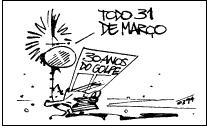 Rango 1968
Rango 1968
The characters of this long-lived comic strip inhabit a garbage dump, exemplifying and protesting the inequalities of Brazil. It's rarely any deeper than a political cartoon; but when the basic situation of the country remains the same, it's valuable to have a voice that keeps suggesting that violence, poverty, and corruption are not acceptable. The drawing is brushwork, very fast-looking. A typical joke:
Kid: Dad, how does the neoliberal plan work?
Rango: It's simple: Whoever can, can.
Kid: And those who can't?
Rango: Are canned.
Sottovoce: A Morte Fala Baixo [Death Speaks Softly] 1997
In his introduction, Vasques complains that comics are still, in Brazil, considered things for children, whereas he sees them as one of the most sophisticated forms of narrative. This story is his attempt to prove his point.
In form, it's a mystery: a newspaper reporter named Parola begins investigating the death of a politician. He soon encounters shadowy figures from the era of the dictatorship, damsels in distress, and an avenging figure out of Venetian legend. The artwork is executed with an expert breeziness; the characters are interesting; my only complaint is that at the end Vasques tries to reveal everything, and ends up with a story that doesn't hold true to its own beginnings.

 Detective stories à la Hammett and Chandler, turned into farce.
Ed Mort is a private eye, always one step away from total ruin.
The drawing style is simple and caricatured, but uses blacks well.
They originally appeared as a newspaper strip, so they're punctuated every
few panels by jokes:
Detective stories à la Hammett and Chandler, turned into farce.
Ed Mort is a private eye, always one step away from total ruin.
The drawing style is simple and caricatured, but uses blacks well.
They originally appeared as a newspaper strip, so they're punctuated every
few panels by jokes:
She gave me a check as a retainer. A fat check, with many zeroes. I couldn't wait... I ate the check.Deep it's not. But it is pretty funny.Client: I need to find my husband.
Mort: That cretin.
Client: Do you know him?
Mort: No. But already I don't like him.

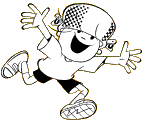 If I'm translating aright, that's "the crazy boy"... take it as a sort
of Brazilian Dennis the Menace. It's typical enough kid strip--
a little mischief, a little precociousness, nothing very challenging,
not even that many reminders that we're not in Kansas anymore.
A typical strip:
If I'm translating aright, that's "the crazy boy"... take it as a sort
of Brazilian Dennis the Menace. It's typical enough kid strip--
a little mischief, a little precociousness, nothing very challenging,
not even that many reminders that we're not in Kansas anymore.
A typical strip:
Girl: How old is your dad?
Menino: It's hard to say. He always says, "In my time things were different." But Mom always tells him, "When are you going to grow up?"

